What gives large formats “depth”, “roundness”, and “dimensionality”?
![]() Adam Wilt, December 10, 2017
Adam Wilt, December 10, 2017
(Originally published at https://www.provideocoalition.com/bigger-better-ok/)
Whether it’s Quentin Tarantino shooting “Hateful Eight” in 65mm, the Panavision Millenium DXL, RED’s VV sensors, the Arri Alexa 65, or the new Sony Venice, large format cinematography is being touted as the Next Big Thing (pun intended). Large format—from full-frame 36 x 24mm to RED/DXL’s 40.96 x 21.60mm, Arri’s 54.12 x 25.58 mm, and beyond—is said to deliver greater depth, dimensionality, roundness, naturalness, and just all-around goodness than plain old Super35mm at 25 x 18mm (more or less, depending on the camera). It’s not uncommon to find rapturous reports of using large formats, and there’s a raging discussion on CML this past week about just why bigger is better.
What strikes me in many of these colloquies is that it’s exceedingly hard to pin down what exactly it is about large format work that gives it that special quality. There tends to be a lot of handwaving, with amorphous terms like “naturalness”, “dimensionality”, and “roundness” that elude definition. Sometimes two images are presented for comparison: shot on different film stocks, of different subjects, with different lighting in different environments, using different aspect ratios (we are not making this up). It’s all a bit too much “is this apple more like a banana, or is this tangerine more like a guava?” for my tastes.
Trust, but verify
In an attempt to better understand the “large format experience”, I decided to shoot the same subjects on two or three formats of different sizes, varying some parameters while keeping others constant. In this way I could look at individual factors, including:
- Aspect ratio
- Resolution
- Focal length / angle of view
- Aperture / depth of field
- “Look-around”
If there’s magic sauce involved, this methodology should squeeze it out.
To that end, I procured two Sony ILCs: an A6300 with a Super35mm-ish sensor, and an A7ii as a full-frame exemplar. Both cameras have the same photosite count so I could match resolutions between formats. They also have similar image rendering characteristics, so I can minimize the effects of differing color and tonal-scale responses.
Both cameras came with kit lenses, a 16–50mm f/3.5–5.6 on the A6300 and a 28–70mm f/3.5–5.6 on the A7ii. These are typical Sony kit zooms: they render images with boringly middle-of-the-road good quality, low distortion, minimal flare, and unfussy bokeh. Importantly, the lenses lack substantial differentiating “character”, so there’s nothing that calls attention to the particular lens used to make an image. Thus I can avoid the sorts of biases that might creep in from shooting one format with a crisp Zeiss prime and the other with, say, a Lomo Petzval.
You might ask why I didn’t get some proper video or cine cameras and lenses for this test, like a Sony F55 for S35mm and a Venice for full frame, and a case full of matched Zeiss primes for each. All I can say is: if you pay for the rentals and insurance, I’ll happily test ’em.
I also threw a Panasonic GH5 into the mix, with an MFT sensor half the width of full-frame. Its photosite count is 14% lower and its color and tone handling are different, but its 12-35mm f/2.8 zoom is just about as boring as the Sony kit zooms when it comes to “character”. I shot all three cameras in their Rec.709 modes (PP4 on the Sonys, Like709 on the Panasonic) to get them all as close as possible to a common rendering.
- Sony A7ii: 35.8 x 20.1 mm (in 16×9); 6000 x 3376 photosites. Full-frame, “FF”
- Sony A6300: 23.5 x 13.2mm (in 16×9); 6000 x 3376 photosites. Super35mm, “S35mm”
- Panasonic GH5: 17.3 x 9.7mm (in 16×9); 5184 x 2916 photosites. Micro Four Thirds, “MFT”
Shall we have a look? I’ll present a series of image comparisons. In each one, I’ve varied one thing while keeping everything else constant—but I won’t say what I’ve done. Have a look at each comparison and see how the images vary—if they do.
For best results use a “large format” tablet, laptop, or desktop machine; a “small format” phone won’t give the clearest view of the images. Yes, sometimes size does matter.
Which images have the most “dimensionality”, “depth”, “roundness”, and/or “naturalness”? What have I changed between the images in a comparison, and how do those changes contribute to the “large format look”?
Afterwards, I’ll show each series again, with explanations and commentary.
If you want to bypass all the freakin’ Junior Detective work and just see what the heck it was I did — because, maybe, just maybe, you have a life and want to get on with it? — then skip past these images.
Series 1
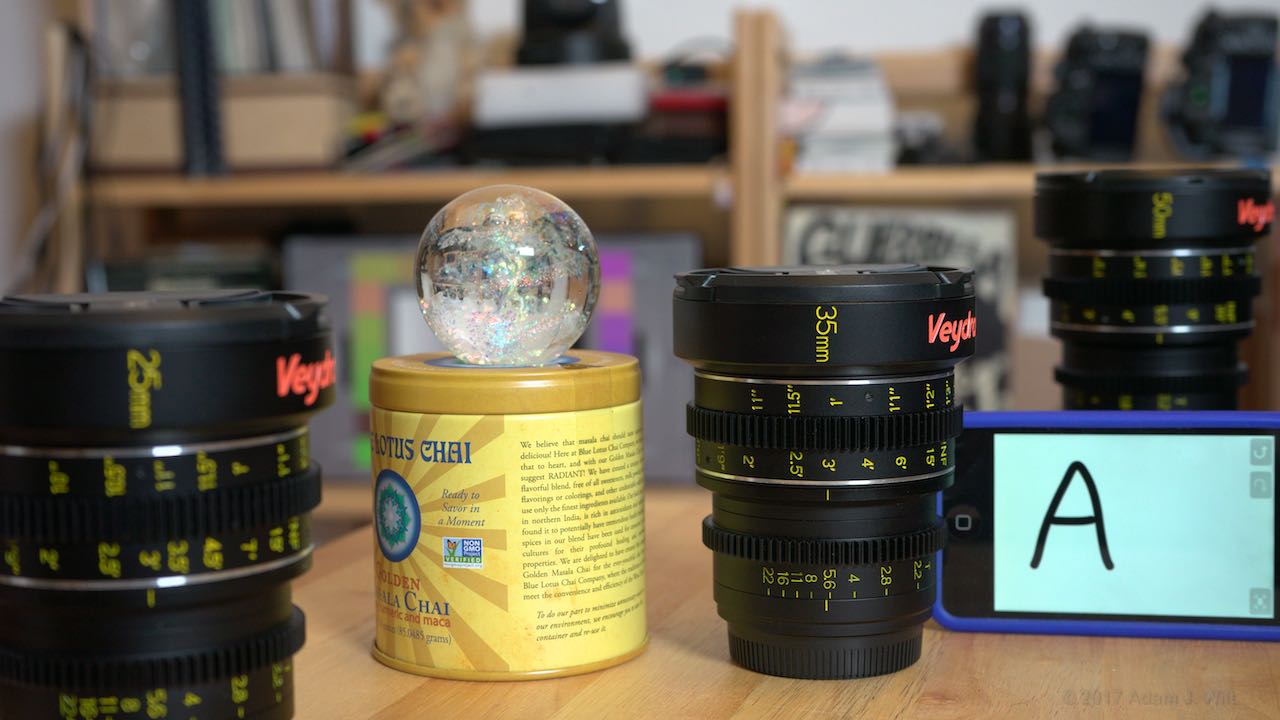
Series 2
Series 3
Series 4
Series 5
Series 6
Series 7
Series 8
Series 9
Howdy! Head chock-full of theories? Got your shot list and scorecard?
Or did you skip ahead, because you’re as frustrated as I am with a whole bunch of random images supposedly better than some other random images and no freakin’ explanation of why or how that’s the case, and wish I’d just get on with it?
No worries. We’re all friends here. Let’s get on with it.
Except as mentioned in each series, everything was kept as constant as possible between shots within the series. Cameras were mounted in the same place, then adjusted up or down and forward or aft slightly to render the same perspective, and the spacing between the tripod socket and the optical axis of the lens differed slightly between cameras, and the optical center of the lens shifts fore and aft with changes in focal length. Some minor post-processing was done to match levels and color saturation.
Except as mentioned, I used native short zooms for all shots. The focal lengths given are nominal, not exact, as focal-length setting was done by eye to match perspectives between shots.
Series 1: same AoV, same DoF
This test is designed to neutralize differences between formats as much as possible.
Lenses were chosen to match angles of view (AoV), and apertures were set to match depth of field (DoF). That meant longer lenses for larger formats, and smaller apertures.
 A7ii, 50mm, f/7.1
A7ii, 50mm, f/7.1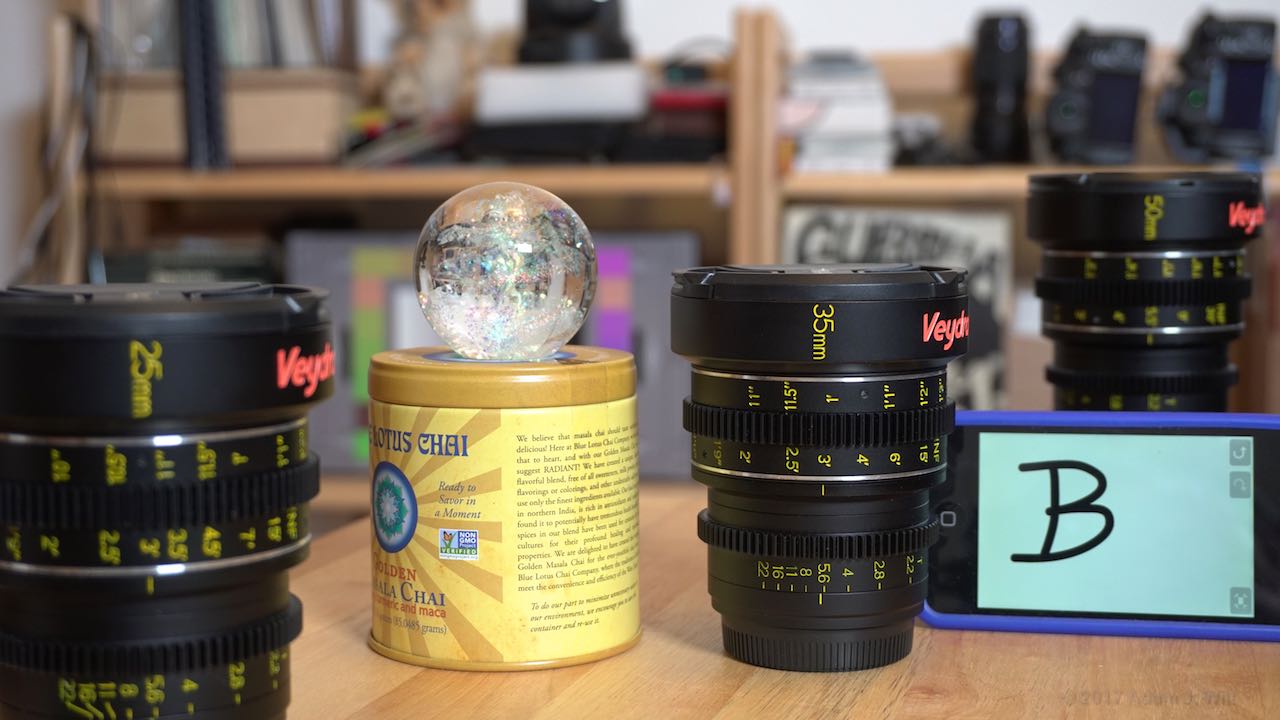 A6300, 33mm, f/5.0
A6300, 33mm, f/5.0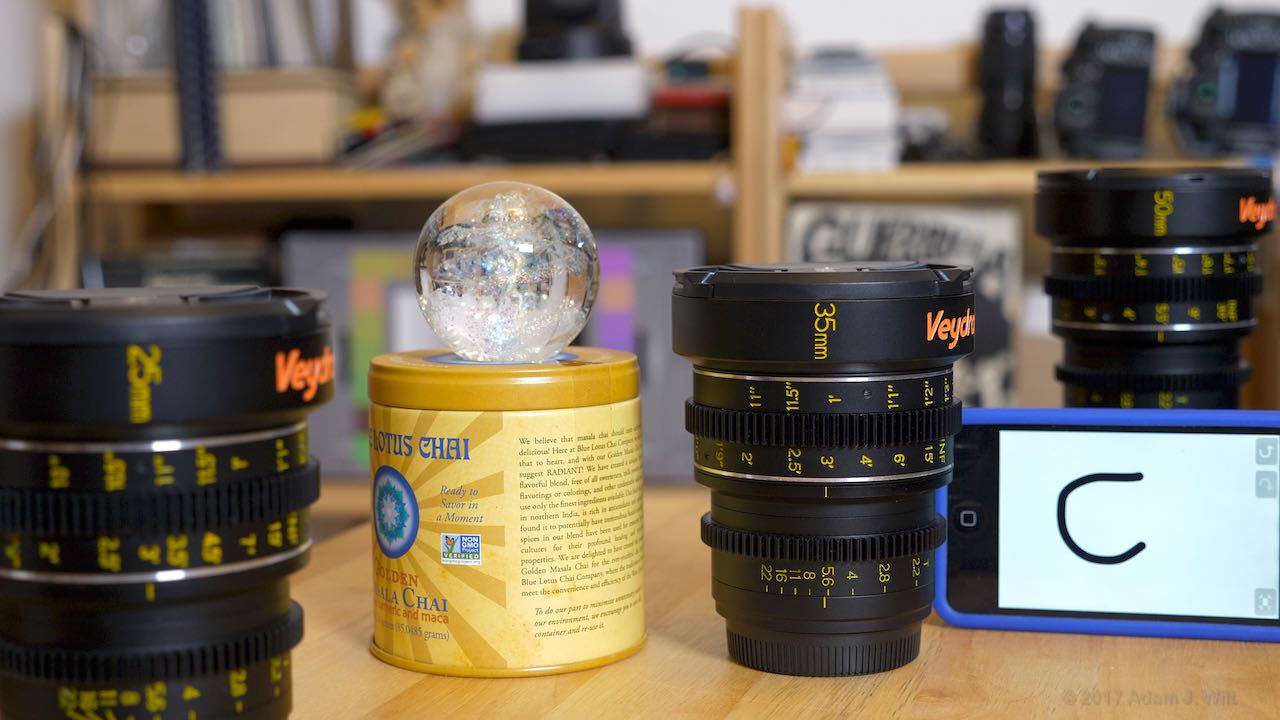 GH5, 25mm, f/3.5
GH5, 25mm, f/3.5
Roughly speaking, lenses need to scale linearly with format size to preserve angle of view, and apertures need to close by a stop for every square-root-of-two size increase. There’s a handy (if rather coarse-grained) Depth of Field Equivalents calculator at CambridgeInColour, though for my tests it was easier and more precise to grab a reference frame from one camera and use it to align the others by eye.
Series 2: same AoV, same aperture
“I usually light for T4 when I shoot S35mm, so why wouldn’t I do the same for FF?” Put another way, “I want to shoot the same perspective at the same stop as I normally do.” What happens when we try that?
 A6300, 33mm, f/5.0
A6300, 33mm, f/5.0 A7ii, 50mm, f/5.0
A7ii, 50mm, f/5.0 GH5, 25mm, f/5.0
GH5, 25mm, f/5.0
No surprise here: for the same AoV with the same aperture, larger formats will have shallower DoF, smaller formats deeper DoF.
Shallower DoF was the “cinematic look” that drove sales of 35mm relay-lens adapters for 2/3″ cameras; that drove electronic cinematography from small sensors to S35mm-sized sensors; and was a large part of the Canon 5D Mk II phenomenon (the 5D Mk II is, of course, a FF camera). Shallower DoF certainly adds “dimensionality” and “depth” to an image, and I suspect that the ease of getting shallower shots on larger formats is a significant part of “the look”.
Series 3: same AoV, contrary apertures
If shooting the same aperture gives larger formats a shallower DoF, can’t we just use larger apertures on smaller formats to get the same result?
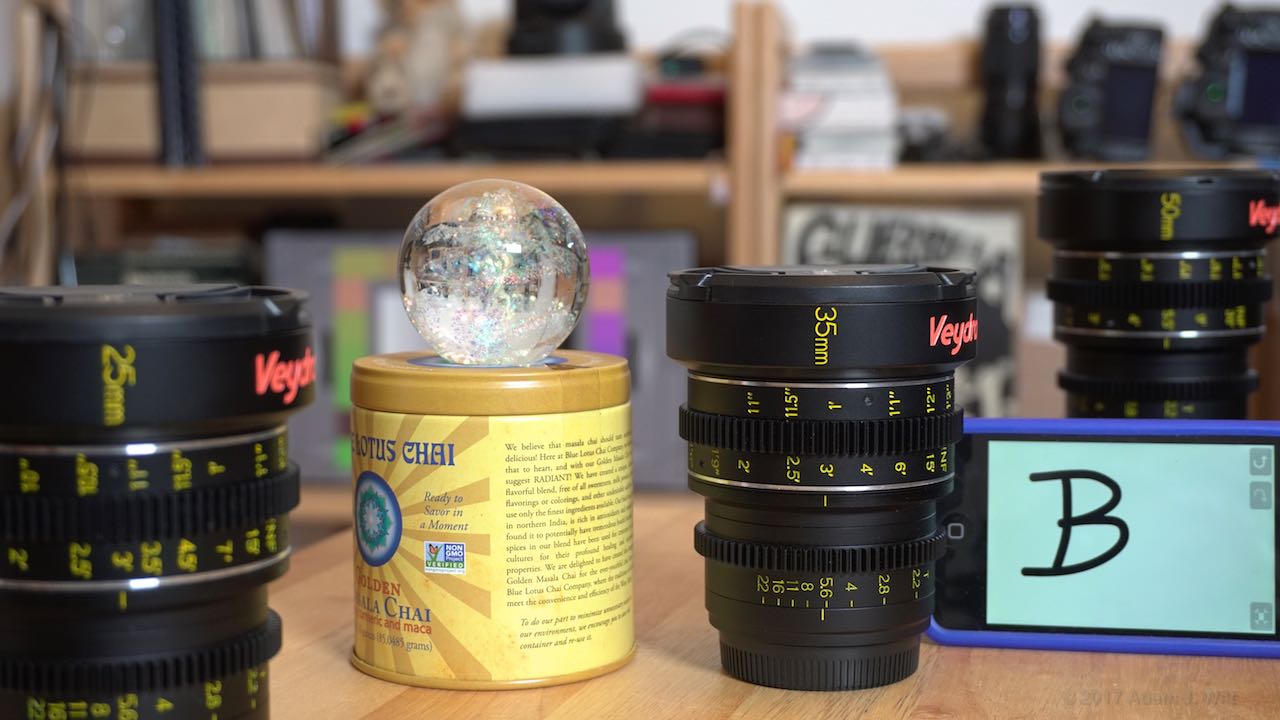 A6300, 33mm, f/5.0
A6300, 33mm, f/5.0 A7ii, 50mm, f/10
A7ii, 50mm, f/10 GH5, Nokton 25mm, f/2.5
GH5, Nokton 25mm, f/2.5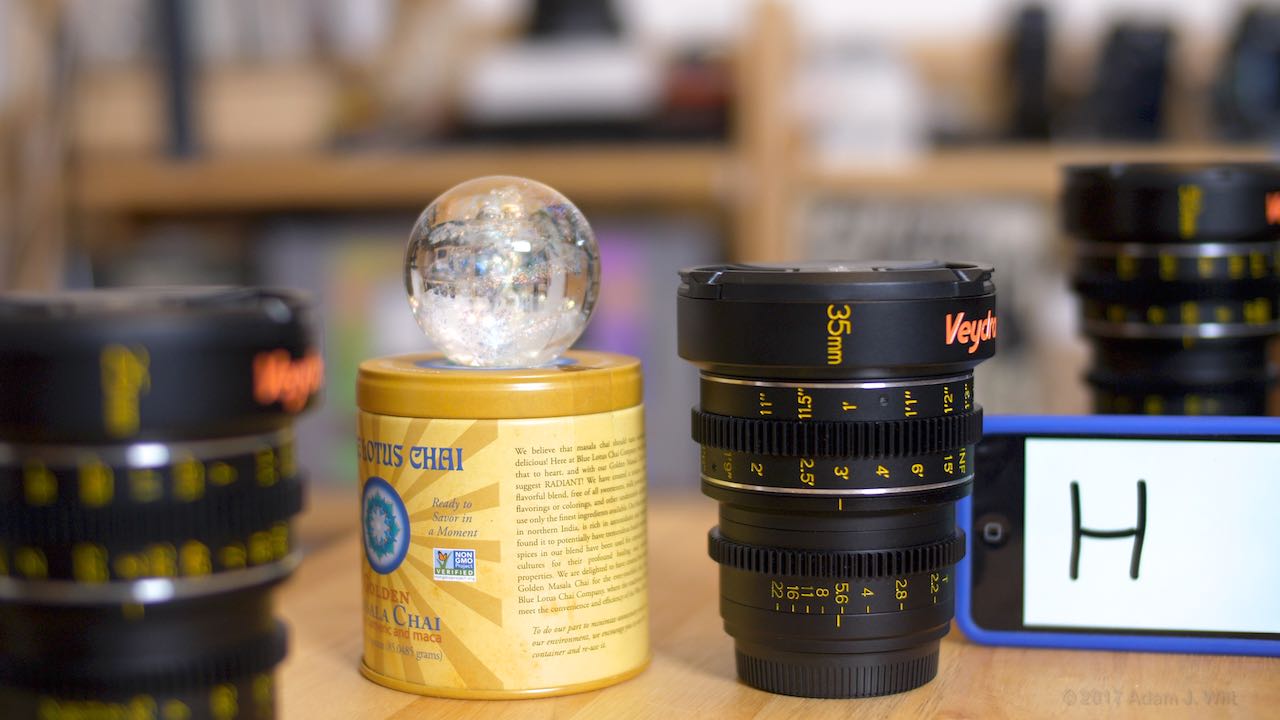 GH5, Nokton 25mm, f/1.8
GH5, Nokton 25mm, f/1.8
I stuck a 25mm Nokton f/0.95 on the GH5 so I could open it wider (and, as a result, I had to slightly crop the two Sony images to match in post, since I foolishly shot them first). I shot the FF A7ii a stop smaller than its equal-depth-of-field stop, and the GH5 at one and two stops wider. So now the larger format image has the deeper DoF and the smaller format is shallower. Does that give the smaller format more “depth” and “dimensionality”?
There are practical limits to this, of course; if you’re shooting an 85mm f/1.2 on your Canon 5D Mk II or Sony Venice, you’d need a 56mm f/0.8 lens to capture the same DoF on a S35mm sensor, or a 43mm f/0.6 on MFT. If shallow DoF is your thing, larger formats have a natural advantage.
Series 4: aspect ratio
 A6300, 33mm, f/5.0, 1.78:1
A6300, 33mm, f/5.0, 1.78:1 A6300, 33mm, f/5,0, 1.5:1
A6300, 33mm, f/5,0, 1.5:1
OK, this seems silly on the face of it, but I have seen arguments that a lower aspect ratio gives the image more “roundness” (and not just because the aspect ratio of a circle is 1:1, grin). I’m not sure if I buy that argument, but the taller picture does provide more room to gaze around and develop ambience and context.
If this is the case, then one could make the argument that returning to squarer images develops better dimensionality. Is 1.78:1 (16×9) already too flattened, never mind Univisium (2:1) or ‘scope (2.39:1)? Is the push for widescreen a mistake?
Series 5: look-around, f/5.0
“Look-around” is the theory that a lens with a larger front element “looks around” the subject more than a smaller lens does: at its periphery, it can collect light rays coming from further around the sides of the subject than a smaller lens can.
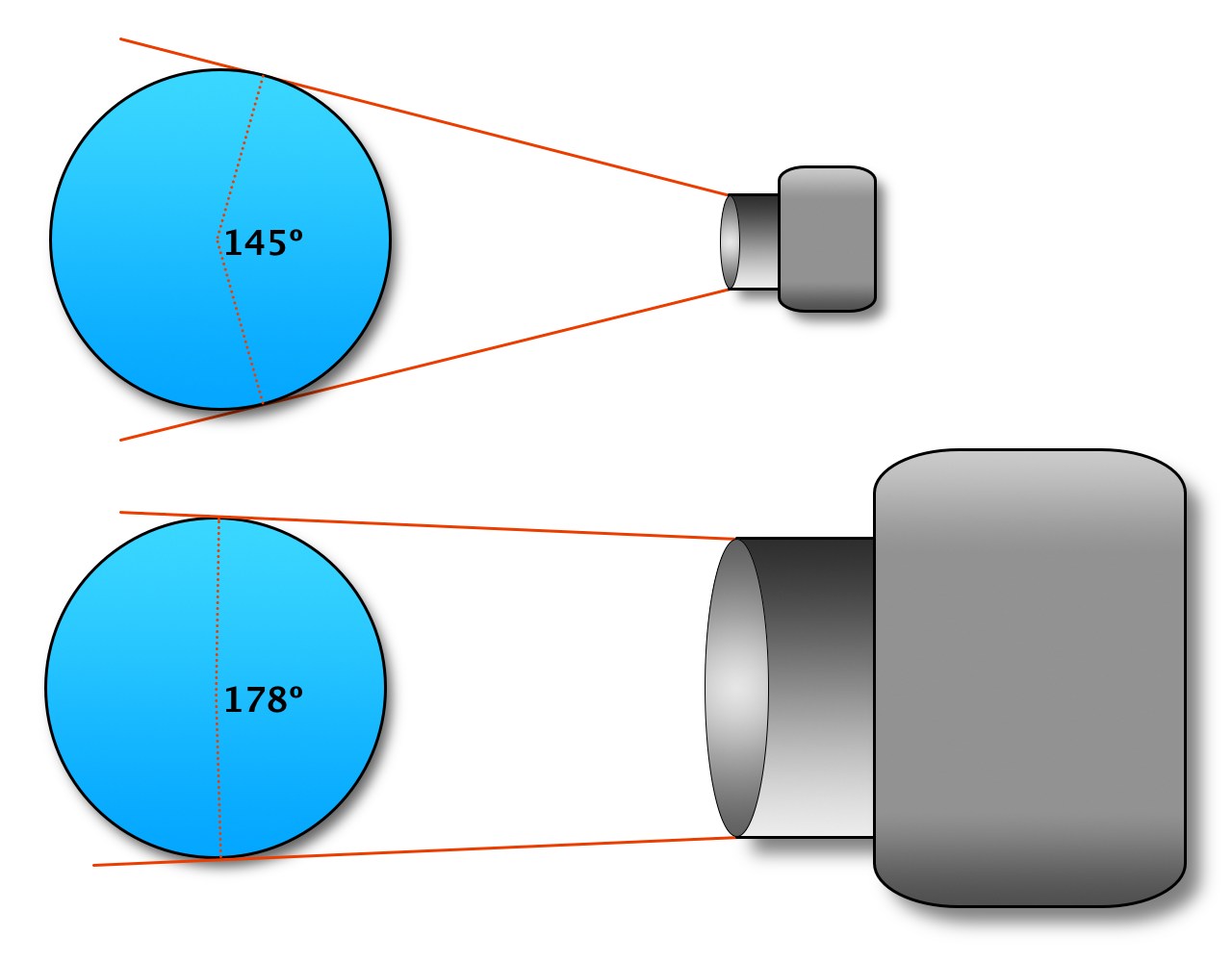 Look-around: here, the smaller camera and lens can “see” about 145º around the subject, while the larger camera and lens “see” nearly 180º around the same subject. That’s the theory, anyway.
Look-around: here, the smaller camera and lens can “see” about 145º around the subject, while the larger camera and lens “see” nearly 180º around the same subject. That’s the theory, anyway.
To test this effect directly, I took three different 50mm lenses with different front element sizes and stuck them on the A7ii: the kit zoom with a ~33mm front element; a Nikon 50mm 1:1.4 D at 36mm across; and a Sigma 50mm 1:1.4 DG HSM with a front element nearly 58mm across.
All three were shot at f/5.0. Focus was placed on the 11.5″ mark on the 35mm prime.
 A7II, Sony 28–70mm, f/5.0
A7II, Sony 28–70mm, f/5.0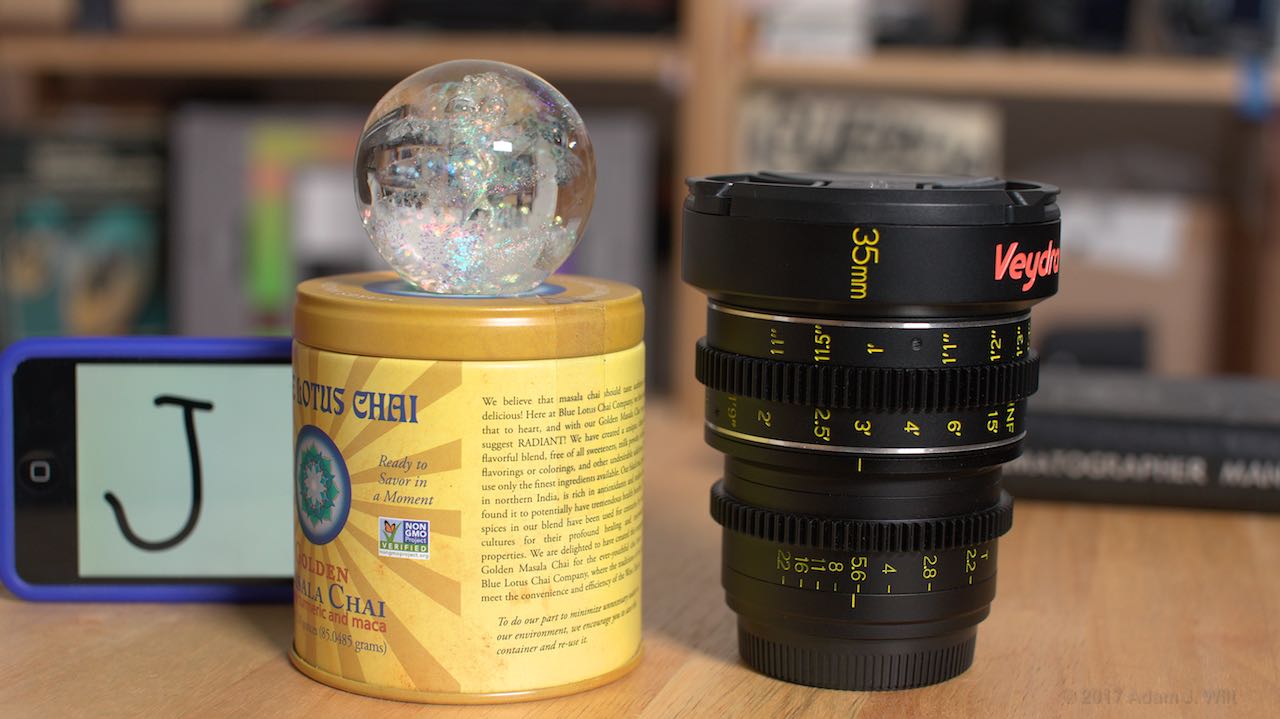 A7ii, Sigma 50mm, f/5.0
A7ii, Sigma 50mm, f/5.0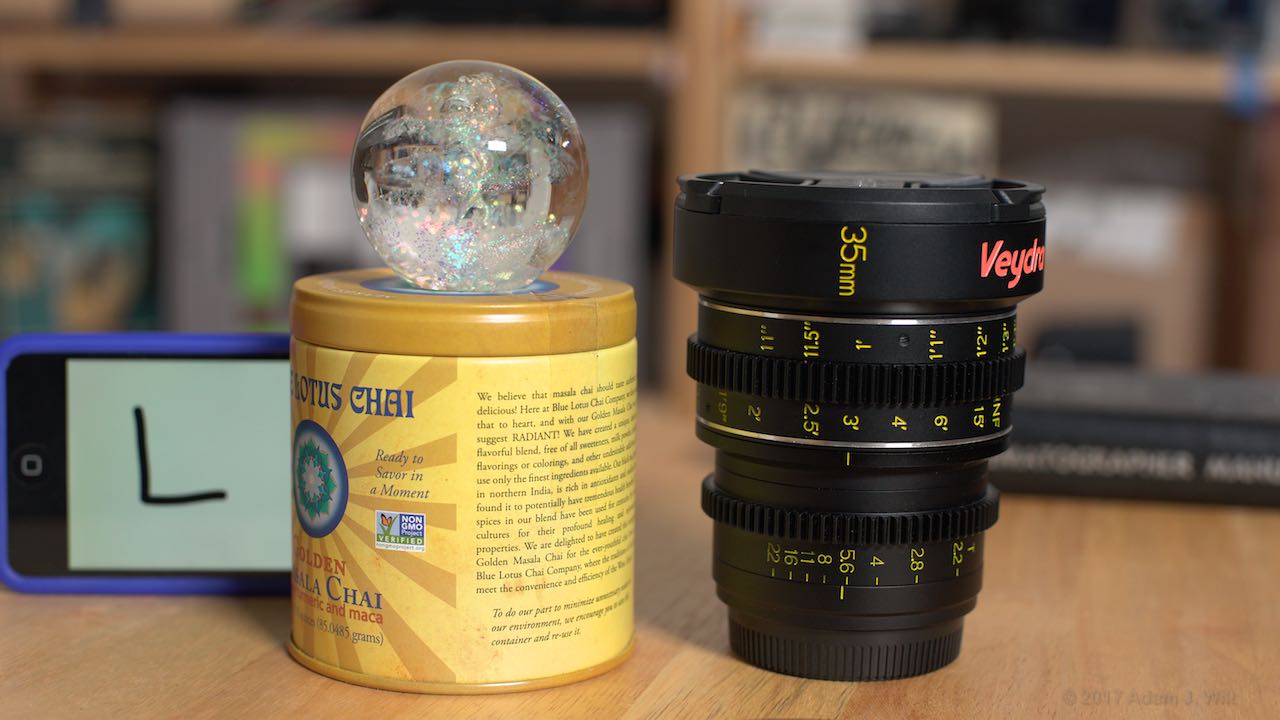 A7ii, Nikon 50mm, f/5.0
A7ii, Nikon 50mm, f/5.0
I don’t see a noticeable difference myself. Your eyeballs may vary.
Series 6: look-around, f/1.4
Mind you, f/5.0 is a small aperture for the f/1.4 lenses. If I open ’em wide, I might see more of a difference:
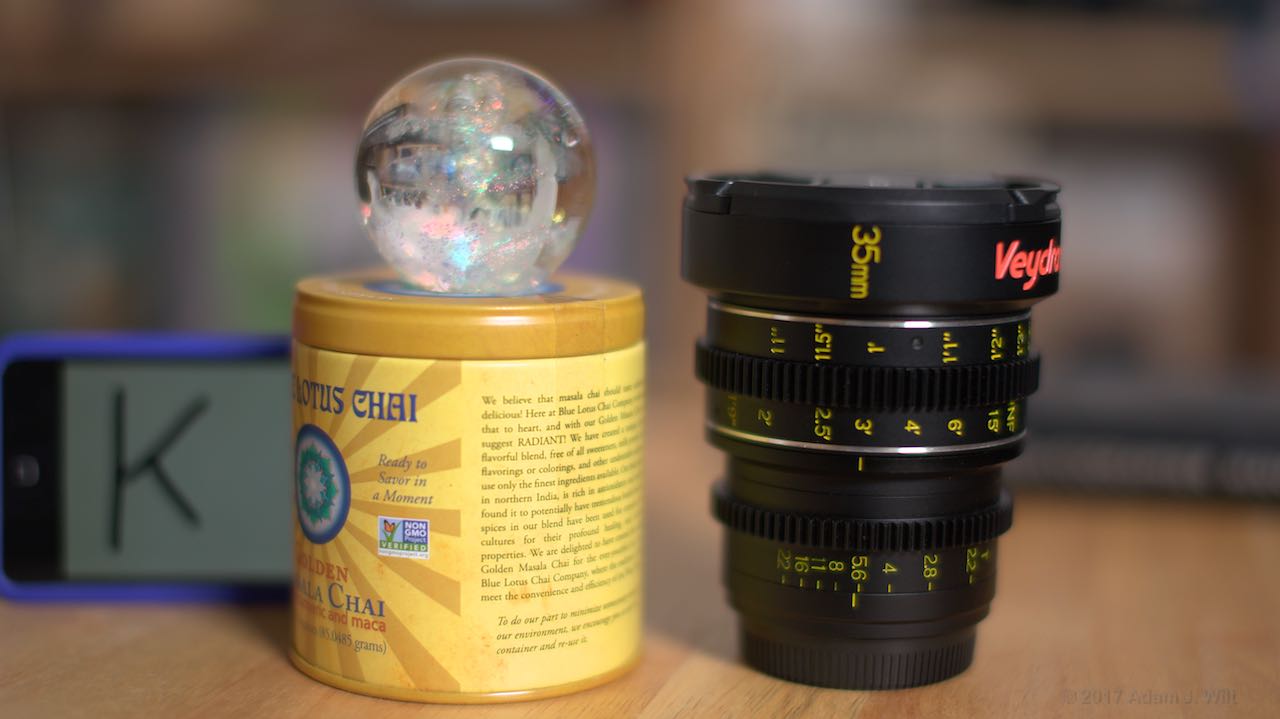 A7ii, Sigma 50mm, f/1.4
A7ii, Sigma 50mm, f/1.4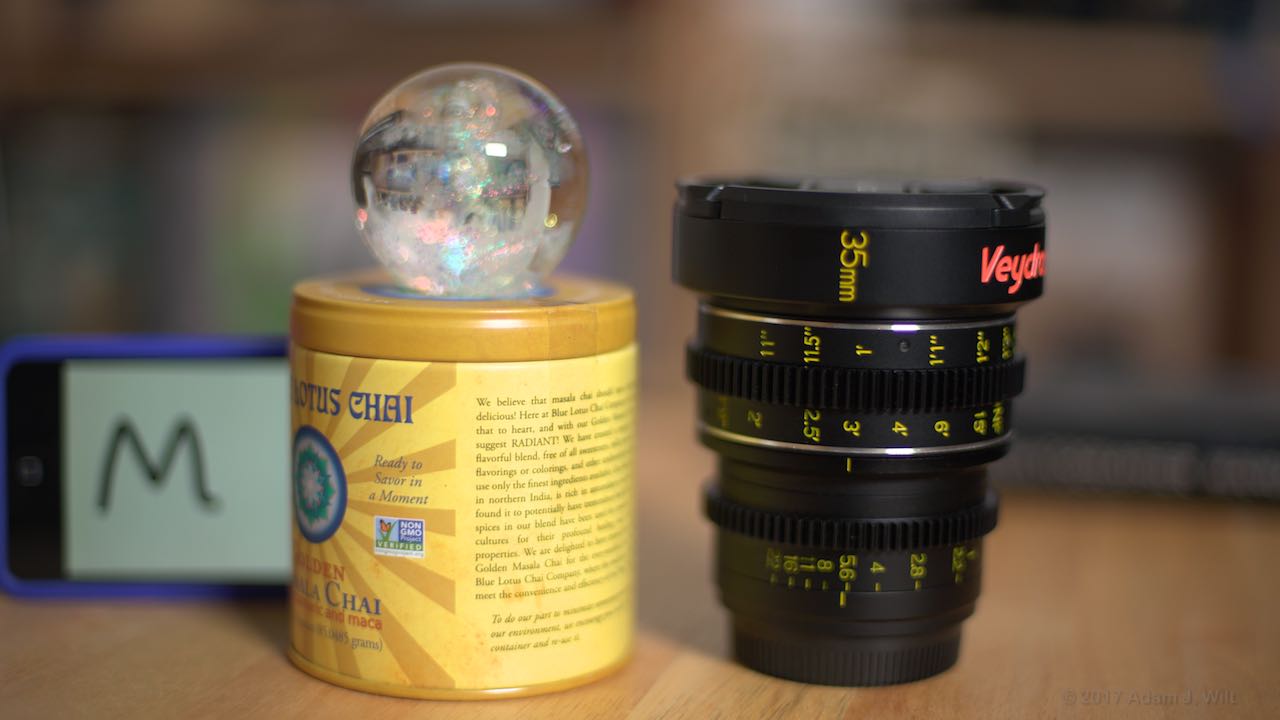 A7ii, Nikon 50mm, f/1.4
A7ii, Nikon 50mm, f/1.4
I’m still not seeing a significant difference.
You can argue that I’m not doing a proper test: I should also throw in a small-sensor “matched” image:
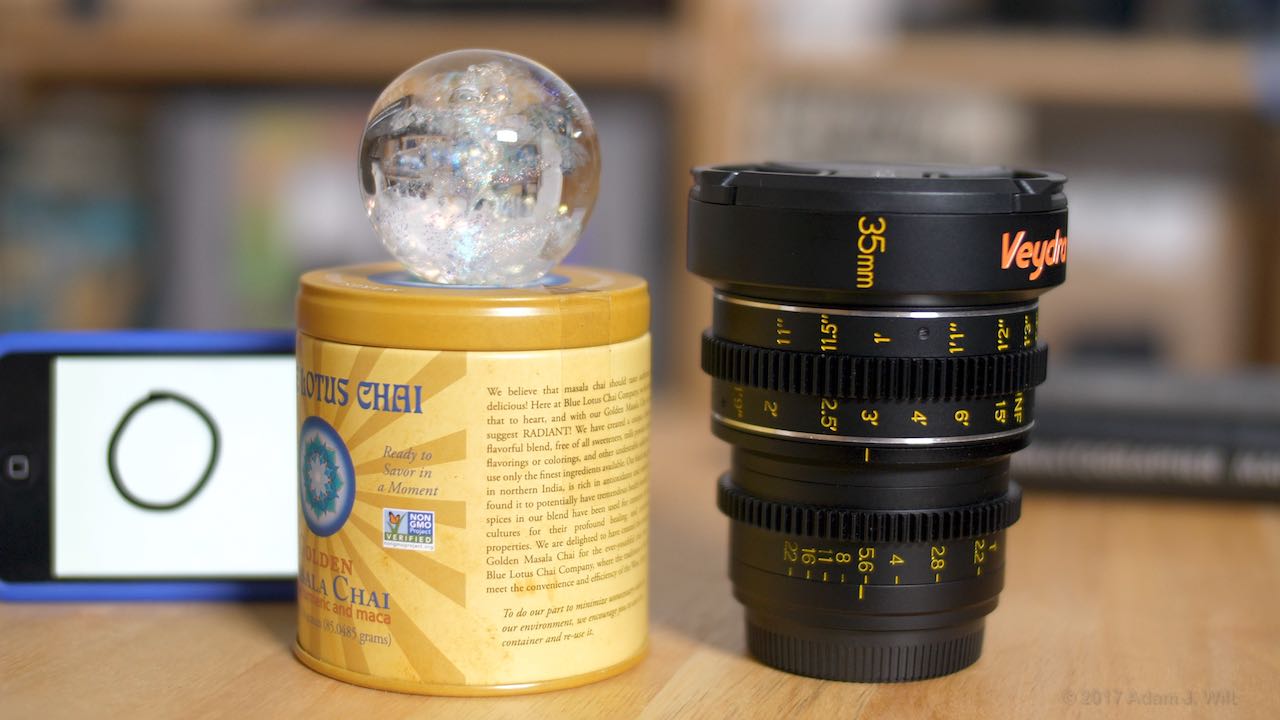 GH5, Nokton 25mm, f/1.4
GH5, Nokton 25mm, f/1.4
But now the DoF is different. If anything, the deeper DoF ’round the edges of the chai tin gives me more of a sense of it—but this f/1.4 comparison is shallower than most normal shots in both cases, so I shouldn’t read too much into it in any event.
Series 7: same focal length, same aperture, same position
For completeness, I took the exact same lens, a Nikon 35mm 1:2 D, and put it on all three cameras at f/4.0.
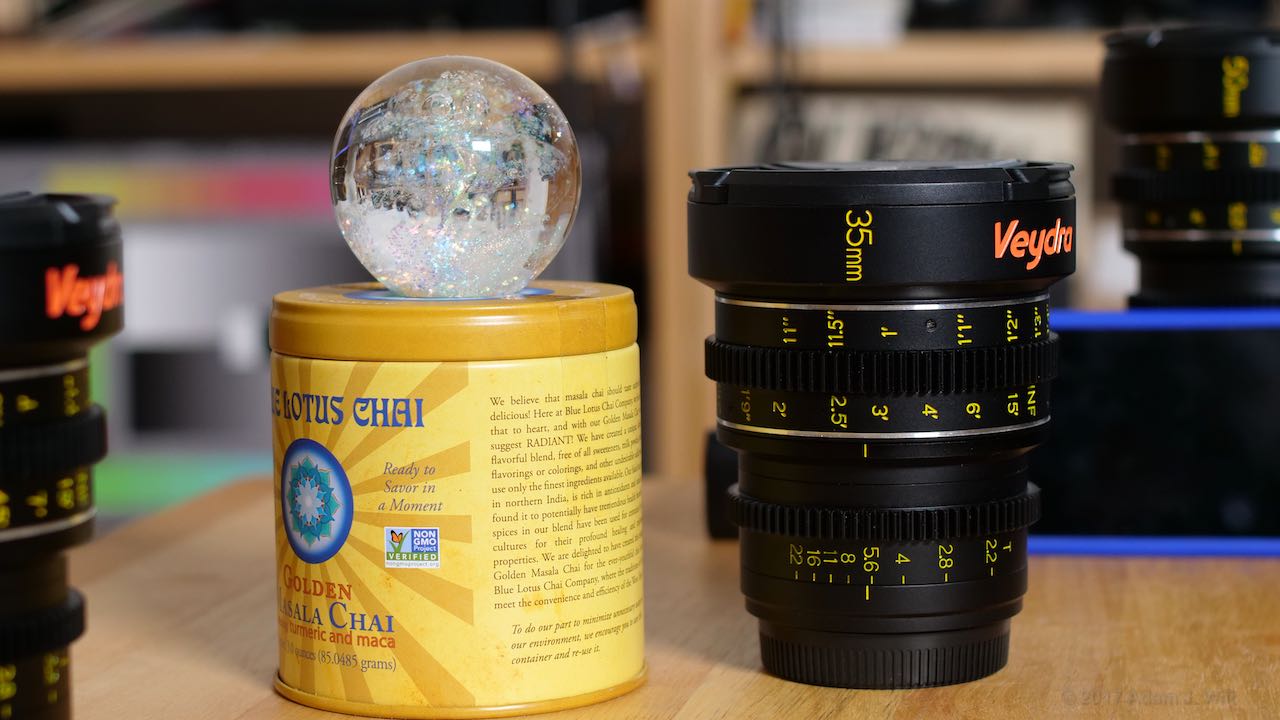 GH5, Nikon 35mm, f/4.0
GH5, Nikon 35mm, f/4.0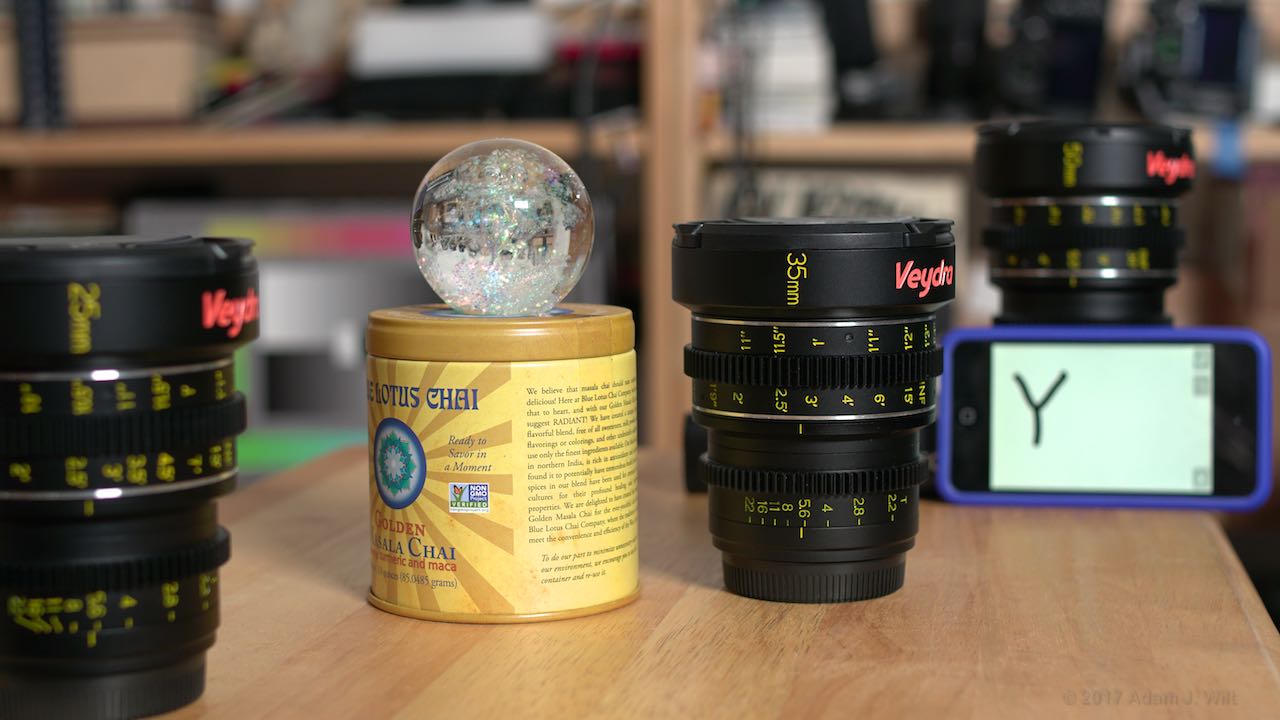 A6300, Nikon 35mm, f/4.0
A6300, Nikon 35mm, f/4.0 A7ii, Nikon 35mm, f/4.0
A7ii, Nikon 35mm, f/4.0
In this case I left all three cameras in the same place, so the perspective is the same in all three shots. If I were focusing on my subject, though, I’d tend to bring my larger format cameras closer, to keep the subject size the same…
Series 8: same focal length, same aperture, same size
…So I kept the same lens, same aperture, and moved the camera to keep my subjects framed the same size.
 A7ii, Nikon 35mm, f/5.6
A7ii, Nikon 35mm, f/5.6 A6300, Nikon 35mm, f/5.6
A6300, Nikon 35mm, f/5.6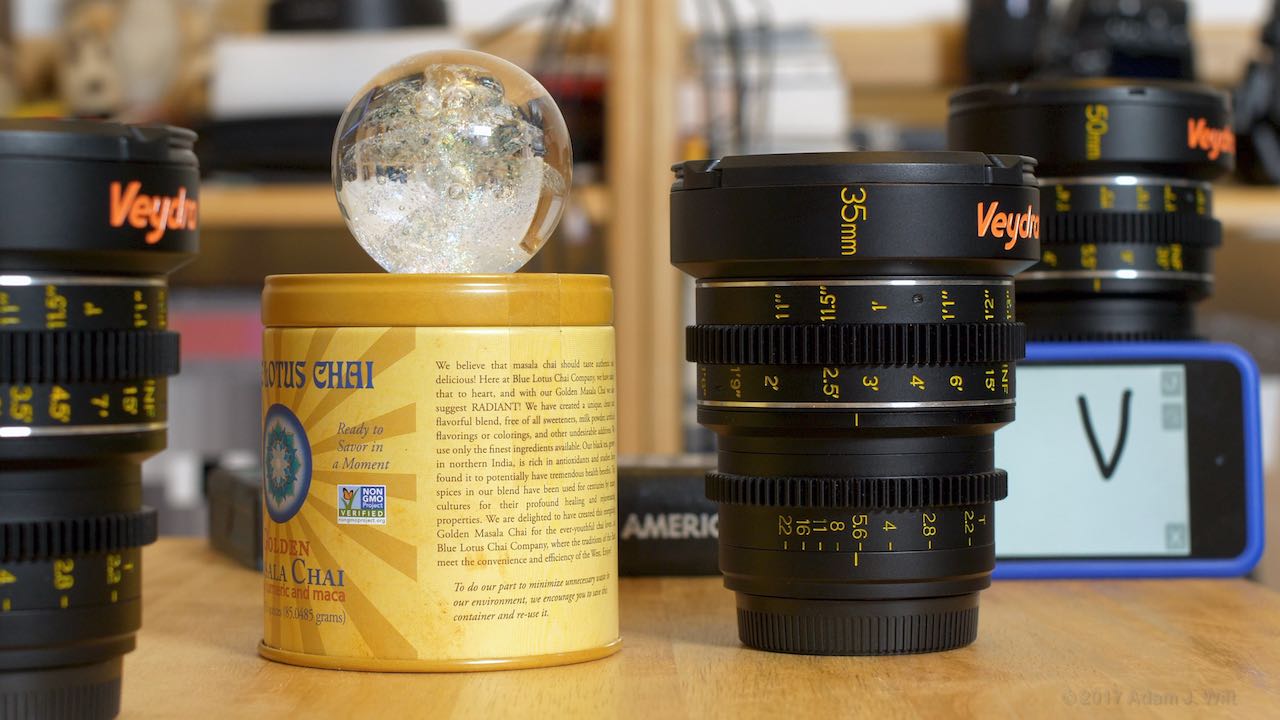 GH5, Nikon 35mm, f/5.6
GH5, Nikon 35mm, f/5.6
This exaggerates perspective on larger formats, as a 35mm on full frame is a wider lens than a 35mm on MFT. Exaggerated perspective helps separate elements in a shot, whereas telephoto images with compressed perspective tends to flatten depth.
If you tend to shoot the same focal lengths on FF that you’re comfortable with on S35mm, that resulting perspective change will indeed add “depth” and “dimensionality” to the image, will it not?
Series 9: resolution
Yeah, this is a big one (pun intended. Again). When you’re shooting film, bigger is indubitably better: a larger film frame records more detail and has a tighter grain pattern, all else being equal.
In digital, it’s often the case that a bigger frame captures more detail: most of the S35mm sensors in cine cameras are in the 2K to 4K range, while the Alexa 65, Millenium DXL, and RED VV sensors are pushing into the 6K–8K range.
I specifically chose my two Sonys to have the same resolutions, so I faked the difference here. I simply took a version of my reference image and downsampled it 2x before upscaling it back to the presentation size.
 A6300, scaled down to 720p, then to 360p, then back to 720p
A6300, scaled down to 720p, then to 360p, then back to 720p A6300, scaled down to 720p
A6300, scaled down to 720p
When you have more resolution in a frame, there’s a more “transparent” appearance to it, and more differentiation between sharp and unsharp elements. It wins for “depth” and “dimensionality”.
What if you keep the photosite counts the same on large and small sensors? There’s still a tradeoff: the smaller sensor’s photosites need to be smaller, so the smaller sensor will have lower sensitivity, lower dynamic range, and/or higher noise. In bright light with normal contrasts, these differences are minimal, but you’ll see the impact once the light starts dimming and the scenes get more dynamically challenging.
Finally, there’s one unavoidable differentiator: physics. To capture the same detail, an MFT sensor’s lens needs to have twice the resolving power of a FF sensor’s lens: the small sensor’s lens needs twice the precision in its grinding and assembly, even if it uses the exact same optical formula at half the size. Put another way, the lens has to be just as carefully built regardless of size, but the required tolerances get tighter as the lens gets smaller.
If that’s not bad enough, diffraction limits are more of a factor the smaller your optical system gets, limiting the sharpness you can render at small apertures.
So, yes, even if your large format has the same resolution as a smaller format, it will be less limited by the laws of physics. The differences may be minimal, and with careful choice of glass, lighting, and subject matter you can minimize them—but they’re still lurking in the background.
Conclusions?
“Conclusions” is too strong a word. “Findings so far” is more like it, and here’s what I’ve found so far:
- If you match resolution, angle of view and depth of field, a large format image looks very much like a small format image. This requires stopping down the large format lens: if you normally shoot f/4 on S35mm, you’d shoot closer to f/5.6 on FF for the same depth of field.
- If instead you match angle of view and use the same aperture, the large format image has shallower depth of field: about a stop shallower on FF compared to S35mm.
- If you match focal length and aperture, and reframe for the same subject size, the larger format winds up with a wider-angle view, with more exaggerated depth.
- Large lens “look around” doesn’t appear to make a significant difference, at least not based on these tests. Maybe if I compared a small-fronted prime with the humongous Angenieux Optimo 24-290mm I might see something more?
- A larger sensor with the same photosite density as a smaller sensor will have higher resolution (the same is true for film frames). All else being equal, higher resolution yields pictures with more “transparency” and thus (I’d argue) more “depth”, “dimensionality”, and “naturalness”.
- A larger sensor with the same photosite count as a smaller sensor will have better noise performance, sensitivity, and/or dynamic range, though these differences may not always be apparent.
- Pesky physical factors of precision and diffraction limit the quality you can get from small formats more than from large formats.
Obviously point #5 contributes to the “large format experience” with film and with the new generation of better-than-4K large format digital cine cameras. Even for a 2K or 4K DCI (or Netflix / Amazon) delivery, supersampling works.
I suspect that the other significant factor is #2: I think larger formats encourage the use of shallower depths of field, though I don’t have hard data to prove that it’s happening. Certainly the Canon 5D Mk II “look” in vogue a few years back was almost entirely due to razor-thin depth of field; it definitely wasn’t due to resolution! Maybe there’s a bit of #3 occurring as well?
Beyond that, I don’t see any evidence of “look-around” having an effect. And while #6 and #7 become significant for really small formats, like 2/3″ and smaller, they’re less troublesome at MFT and S35mm sizes, as long as you know what the limits are.
If aspect ratio differences lead to different perceptions of “dimensionality” and “roundness” that’s a fascinating thing in its own right—but it’s not inherent in format size.
In short, I don’t think there’s anything inescapably “large format” about the “large format experience”: there’s a combination of (usually) higher resolution and different image compositions—shallower DoF, possibly a slightly wider “normal” angle of view—that leads to the impressions of “depth”, “dimensionality”, “roundness”, and “naturalness”.
But I could be wrong: please use the comments section [on the original website] to tell me exactly why and how that’s the case, and point me to counterexamples!
I’m just starting this investigation, and I plan to take my two Sonys out over the next few weeks and shoot lots of same AoV, varying DoF A/B comparisons, keeping resolution constant. If I find anything interesting I’ll follow up with another article. Likewise, if you can think of other tests to cast more light on the subject, let me know.
Disclosure: Nobody’s paying me diddley-squat to push any particular point of view or flog a bit of gear to an unsuspecting public. The color chart in the background was supplied by DSC Labs for an earlier test and Bruce Johnson gave me the copy of “Guerrilla Television”, but everything else used in the tests was purchased used or new by yours truly at market rates. The opinions expressed are mine alone, and they’re darned fine opinions… in my opinion. Your opinion may vary.
Copyright © CML. All rights reserved.
- aces.png
- aces.png
- aces.png
- aces.png
- 24-7.jpg
- 24-7.jpg
- arri.png
- arri.png
- BandH.jpg
- camalot.png
- camalot.png
- dedo.png
- dsc.png
- dsc.png
- kino.png
- Hawk.png
- JustCinemaGear.jpg
- Leitz_logo.png
- Leitz_logo.png
- Lowing.gif
- LupoLogo.png
- Module8Logo.png
- LVR.png
- LVR.png
- MO_SYS.png
- MO_SYS.png
- NPV_new_logo-(3)-(002).png
- lindseyo.jpg
- Aputure.png
- TC Logo Centered K_2.png
- VMI.png
- zeiss-logo.png
- zeiss-logo.png
- aces.png
- aces.png
- aces.png
- aces.png
- 24-7.jpg
- 24-7.jpg
- arri.png
- arri.png
- BandH.jpg
- camalot.png
- camalot.png
- dedo.png
- dsc.png
- dsc.png
- FUJINON.jpg
- JustCinemaGear.jpg
- Leitz_logo.png
- Leitz_logo.png
- LVR.png
- LVR.png
- MO_SYS.png
- MO_SYS.png
- NPV_new_logo-(3)-(002).png
- FilmLightLogo.png
FilmLight
- nuke1.png
- theKeep.png
- NewLifeCineLogo.png
- PostWorks.png
- Aputure.png
- TCS.png
- TC Logo Centered K_2.png
- zeiss-logo.png
- zeiss-logo.png
- aces.png
- aces.png
- aces.png
- aces.png
- 24-7.jpg
- 24-7.jpg
- arri.png
- arri.png
- BandH.jpg
- camalot.png
- camalot.png
- dedo.png
- dsc.png
- dsc.png
- kino.png
- Hawk.png
- JustCinemaGear.jpg
- Leitz_logo.png
- Leitz_logo.png
- Lowing.gif
- LupoLogo.png
- Module8Logo.png
- LVR.png
- LVR.png
- MO_SYS.png
- MO_SYS.png
- NPV_new_logo-(3)-(002).png
- lindseyo.jpg
- Aputure.png
- TC Logo Centered K_2.png
- VMI.png
- zeiss-logo.png
- zeiss-logo.png
- aces.png
- aces.png
- aces.png
- aces.png
- 24-7.jpg
- 24-7.jpg
- arri.png
- arri.png
- BandH.jpg
- camalot.png
- camalot.png
- dedo.png
- dsc.png
- dsc.png
- FUJINON.jpg
- JustCinemaGear.jpg
- Leitz_logo.png
- Leitz_logo.png
- LVR.png
- LVR.png
- MO_SYS.png
- MO_SYS.png
- NPV_new_logo-(3)-(002).png
- FilmLightLogo.png
FilmLight
- nuke1.png
- theKeep.png
- NewLifeCineLogo.png
- PostWorks.png
- Aputure.png
- TCS.png
- TC Logo Centered K_2.png
- zeiss-logo.png
- zeiss-logo.png
- aces.png
- aces.png
- aces.png
- aces.png
- 24-7.jpg
- 24-7.jpg
- arri.png
- arri.png
- BandH.jpg
- camalot.png
- camalot.png
- dedo.png
- dsc.png
- dsc.png
- kino.png
- Hawk.png
- JustCinemaGear.jpg
- Leitz_logo.png
- Leitz_logo.png
- Lowing.gif
- LupoLogo.png
- Module8Logo.png
- LVR.png
- LVR.png
- MO_SYS.png
- MO_SYS.png
- NPV_new_logo-(3)-(002).png
- lindseyo.jpg
- Aputure.png
- TC Logo Centered K_2.png
- VMI.png
- zeiss-logo.png
- zeiss-logo.png
- aces.png
- aces.png
- aces.png
- aces.png
- 24-7.jpg
- 24-7.jpg
- arri.png
- arri.png
- BandH.jpg
- camalot.png
- camalot.png
- dedo.png
- dsc.png
- dsc.png
- FUJINON.jpg
- JustCinemaGear.jpg
- Leitz_logo.png
- Leitz_logo.png
- LVR.png
- LVR.png
- MO_SYS.png
- MO_SYS.png
- NPV_new_logo-(3)-(002).png
- FilmLightLogo.png
FilmLight
- nuke1.png
- theKeep.png
- NewLifeCineLogo.png
- PostWorks.png
- Aputure.png
- TCS.png
- TC Logo Centered K_2.png
- zeiss-logo.png
- zeiss-logo.png
- aces.png
- aces.png
- aces.png
- aces.png
- 24-7.jpg
- 24-7.jpg
- arri.png
- arri.png
- BandH.jpg
- camalot.png
- camalot.png
- dedo.png
- dsc.png
- dsc.png
- kino.png
- Hawk.png
- JustCinemaGear.jpg
- Leitz_logo.png
- Leitz_logo.png
- Lowing.gif
- LupoLogo.png
- Module8Logo.png
- LVR.png
- LVR.png
- MO_SYS.png
- MO_SYS.png
- NPV_new_logo-(3)-(002).png
- lindseyo.jpg
- Aputure.png
- TC Logo Centered K_2.png
- VMI.png
- zeiss-logo.png
- zeiss-logo.png



